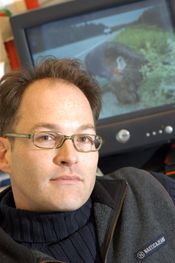Research Examines Collisions Between Vehicles and Moose
November 25, 2004 for immediate release
A unique UNBC study has found that moose collisions with vehicles arehappening as often as 30 times per year within Prince George citylimits.

"Whileit's believed the number is on the rise, we don't really know for sure,and we're only starting to get a good handle on where collisions areoccurring," says UNBC researcher and lab instructor Roy Rea. "With eachcollision averaging just over $5000 in material damage, the problem isan expensive one." The UNBC research team collected records andanecdotal information from the City, RCMP, ICBC, tow truck companies,local insurance brokers, and other agencies that have information onmoose-vehicle collisions. "We took this information and used therecords to plot collision hotspots. Our findings have shown that theyare usually in areas adjacent to greenbelts where speed limits arehigher and lighting is limited. Examples include Highway 16 near thejail, North Nechako and Foothills, University Way, and Tyner Boulevard.Unlike on our highways, there is no one organization responsible forcollecting information on where and when moose collisions occur withincity limits."
In fact, the research marks one of the first times anywhere thatresearchers have examined moose collisions with vehicles within amunicipality. As a result, there is limited information on effectivestrategies for reducing the number of collisions. "We're recommendingthe development of a GIS database on the web that will allow an agencyor resident to log a collision - or even a sighting - on a map. Thiswill give us more comprehensive information for implementingappropriate counter-measures. To date, moose warning signage has beenour only counter-measure in Prince George."
The research project has been supported by The City of Prince George,ICBC, Brownridge and Company Insurance Services, Sussex InsuranceAgency, Nauroth & Associates Insurance Brokers, and BartonInsurance Brokers. Roy Rea has been leading two other research projectsrelated to moose in the area: one has measured the effectiveness ofbrush-cutting roadside plants at different times of year to control thenumber of moose spending time in transportation corridors and theother, conducted in the John Prince Research Forest near Fort St James,has used motion-sensitive cameras to capture moose usage of naturallyoccurring mineral licks.